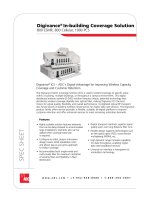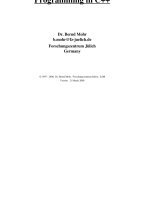Tài liệu Ant in action potx
Bạn đang xem bản rút gọn của tài liệu. Xem và tải ngay bản đầy đủ của tài liệu tại đây (18.35 MB, 600 trang )
www.it-ebooks.info
Praise for the First Edition
“Overall, Java Development with Ant is an excellent resource rich in
valuable information that is well organized and clearly presented.”
—Slashdot.org
“If you are using Ant, get this book.”
—Rick Hightower, co-author of
Java Tools for eXtreme Programming
“This is the indispensable Ant reference.”
—Nicholas Lesiecki, co-author of
Java Tools for eXtreme Programming
“Java Development with Ant is essential for anyone serious about actually
shipping Java applications. I wish I could say I wrote it.”
—Stuart Halloway
Chief Technical Officer, DevelopMentor
Author, Component Development
for the Java Platform
“Erik and Steve give you the answers to questions you didn’t even know you
have. Not only is the subject of Ant covered almost in its entirety, but along
the way you pick up all these juicy little tidbits that only one who’s used Ant in
production environments would know.”
—Ted Neward
.NET & Java Author, Instructor
“This should be required reading for all Java developers.”
—Denver Java Users Group
www.it-ebooks.info
www.it-ebooks.info
Ant in Action
Second Edition of
Java Development with Ant
STEVE LOUGHRAN
E
RIK HATCHER
MANNING
Greenwich
(74° w. long.)
www.it-ebooks.info
For online information and ordering of this and other Manning books, please go to
www.manning.com. The publisher offers discounts on this book when ordered in
quantity. For more information, please contact:
Special Sales Department
Manning Publications Co.
Sound View Court 3B Fax: (609) 877-8256
Greenwich, CT 06830 Email:
©2007 by Manning Publications Co. All rights reserved.
No part of this publication may be reproduced, stored in a retrieval system, or transmitted,
in any form or by means electronic, mechanical, photocopying, or otherwise, without prior
written permission of the publisher.
Many of the designations used by manufacturers and sellers to distinguish their products are
claimed as trademarks. Where those designations appear in the book, and Manning
Publications was aware of a trademark claim, the designations have been printed in initial
caps or all caps.
Recognizing the importance of preserving what has been written, it is Manning’s policy to have
the books we publish printed on acid-free paper, and we exert our best efforts to that end.
Manning Publications Co. Copyeditor: Laura Merrill
Sound View Court 3B Typesetter: Denis Dalinnik
Greenwich, CT 06830 Cover designer: Leslie Haimes
ISBN 1-932394-80-X
Printed in the United States of America
1 2 3 4 5 6 7 8 9 10 – MAL – 11 10 09 08 07
www.it-ebooks.info
To my wife, Bina, and our little deployment project, Alexander.
You’ve both been very tolerant of the time I’ve spent
on the computer, either working on the book
or on Ant itself.
www.it-ebooks.info
www.it-ebooks.info
vii
brief contents
1Introducing Ant 5
2 A first Ant build 19
3 Understanding Ant datatypes and properties 47
4 Testing with JUnit 79
5 Packaging projects 110
6 Executing programs 149
7 Distributing our application 179
8 Putting it all together 209
9 Beyond Ant’s core tasks 233
10 Working with big projects 264
11 Managing dependencies 297
12 Developing for the Web 320
13 Working with XML 340
14 Enterprise Java 363
15 Continuous integration 387
16 Deployment 406
17 Writing Ant tasks 443
18 Extending Ant further 483
www.it-ebooks.info
www.it-ebooks.info
ix
contents
preface to the second edition xix
foreword to the first edition xxi
preface to the first edition xxiii
acknowledgments xxv
about this book xxvii
about the authors xxxi
about the cover illustration xxxii
Introduction to the Second Edition 1
Part 1 Learning Ant 3
1Introducing Ant 5
1.1 What is Ant? 5
The core concepts of Ant 6 ✦ Ant in action:
an example project 8
1.2 What makes Ant so special? 11
1.3 When to use Ant 12
1.4 When not to use Ant 13
1.5 Alternatives to Ant 13
IDEs 13 ✦ Make 14 ✦ Maven 16
1.6 The ongoing evolution of Ant 16
1.7 Summary 17
www.it-ebooks.info
x CONTENTS
2 A first Ant build 19
2.1 Defining our first project 19
2.2 Step zero: creating the project directory 20
2.3 Step one: verifying the tools are in place 20
2.4 Step two: writing your first Ant build file 21
Examining the build file 21
2.5 Step three: running your first build 23
If the build fails 23 ✦ Looking at the build in more detail 25
2.6 Step four: imposing structure 27
Laying out the source directories 28 ✦ Laying out the build
directories 29
✦ Laying out the distribution directories 29
Creating the build file 31
✦ Target dependencies 32
Running the new build file 33
✦ Incremental builds 34
Running multiple targets on the command line 35
2.7 Step five: running our program 36
Why execute from inside Ant? 36 ✦ Adding an "execute"
target 37
✦ Running the new target 38
2.8 Ant command-line options 39
Specifying which build file to run 40 ✦ Controlling the amount
of information provided 41
✦ Coping with failure 42
Getting information about a project 42
2.9 Examining the final build file 43
2.10 Running the build under an IDE 44
2.11 Summary 45
3 Understanding Ant datatypes and properties 47
3.1 Preliminaries 48
What is an Ant datatype? 48 ✦ Property overview 48
3.2 Introducing datatypes and properties with <javac> 49
3.3 Paths 52
How to use a path 53
3.4 Filesets 53
Patternsets 54
3.5 Selectors 58
3.6 Additional Ant datatypes 59
3.7 Properties 61
Setting properties with the <property> task 62 ✦ Checking for
the availability of files: <available> 66
✦ Testing conditions with
<condition> 67
✦ Creating a build timestamp with
<tstamp> 69
✦ Setting properties from the command line 70
www.it-ebooks.info
CONTENTS xi
3.8 Controlling Ant with properties 70
Conditional target execution 71 ✦ Conditional build
failure 72
✦ Conditional patternset inclusion/exclusion 72
3.9 References 73
Viewing datatypes 73
3.10 Managing library dependencies 75
3.11 Resources: Ant’s secret data model 76
3.12 Best practices 76
3.13 Summary 77
4 Testing with JUnit 79
4.1 What is testing, and why do it? 80
4.2 Introducing our application 81
The application: a diary 81
4.3 How to test a program 83
4.4 Introducing JUnit 84
Writing a test case 86 ✦ Running a test case 86
Asserting desired results 87
✦ Adding JUnit to Ant 90
Writing the code 92
4.5 The JUnit task: <junit> 93
Fitting JUnit into the build process 94 ✦ Halting the
build when tests fail 96
✦ Viewing test results 96
Running multiple tests with <batchtest> 98
4.6 Generating HTML test reports 99
Halting the builds after generating reports 101
4.7 Advanced <junit> techniques 102
4.8 Best practices 106
The future of JUnit 107
4.9 Summary 108
5 Packaging projects 110
5.1 Working with files 111
Deleting files 112 ✦ Copying files 113 ✦ Moving and
renaming files 114
5.2 Introducing mappers 114
5.3 Modifying files as you go 119
5.4 Preparing to package 120
Adding data files to the classpath 121 ✦ Generating
documentation 122
✦ Patching line endings for
target platforms 124
www.it-ebooks.info
xii CONTENTS
5.5 Creating JAR files 126
Testing the JAR file 128 ✦ Creating JAR manifests 129
Adding extra metadata to the JAR 131
✦ JAR file best
practices 132
✦ Signing JAR files 132
5.6 Testing with JAR files 135
5.7 Creating Zip files 136
Creating a binary Zip distribution 137 ✦ Creating a source
distribution 138
✦ Zip file best practices 139
5.8 Packaging for Unix 139
Tar files 139 ✦ Generating RPM packages 143
5.9 Working with resources 143
A formal definition of a resource 143 ✦ What resources
are there? 144
✦ Resource collections 145
5.10 Summary 147
6 Executing programs 149
6.1 Running programs under Ant—an introduction 149
Introducing the <java> task 151 ✦ Setting the classpath 152
Arguments 153
✦ Defining system properties 155
Running the program in a new JVM 156
✦ JVM tuning 157
Handling errors 158
✦ Executing JAR files 160
6.2 Running native programs 161
Running our diary as a native program 162 ✦ Executing shell
commands 162
✦ Running under different Operating
Systems 163
✦ Probing for a program 166
6.3 Advanced <java> and <exec> 167
Setting environment variables 167 ✦ Handling timeouts 168
Running a program in the background 169
✦ Input and
output 170
✦ Piped I/O with an I/O redirector 171
FilterChains and FilterReaders 172
6.4 Bulk operations with <apply> 174
6.5 How it all works 176
<java> 176 ✦ <exec> and <apply> 177
6.6 Best practices 177
6.7 Summary 178
7 Distributing our application 179
7.1 Preparing for distribution 180
Securing our distribution 181 ✦ Server requirements 183
www.it-ebooks.info
CONTENTS xiii
7.2 FTP-based distribution of a packaged application 183
Uploading to Unix 184 ✦ Uploading to a Windows
FTP server 185
✦ Uploading to SourceForge 186
FTP dependency logic 187
7.3 Email-based distribution of a packaged application 188
Sending HTML messages 191
7.4 Secure distribution with SSH and SCP 192
Uploading files with SCP 193 ✦ Downloading files
with <scp> 195
✦ Remote execution with <sshexec> 197
Troubleshooting the SSH tasks 197
7.5 HTTP download 198
How to probe for a server or web page 199 ✦ Fetching remote
files with <get> 200
✦ Performing the download 201
7.6 Distribution over multiple channels 203
Calling targets with <antcall> 203 ✦ Distributing
with <antcall> 206
7.7 Summary 208
8 Putting it all together 209
8.1 How to write good build files 209
8.2 Building the diary library 210
Starting the project 210 ✦ The public entry points 211
Setting up the build 212
✦ Compiling and testing 216
Packaging and creating a distribution 218
✦ Distribution 222
8.3 Adopting Ant 225
8.4 Building an existing project under Ant 228
8.5 Summary 230
Part 2 Applying Ant 231
9 Beyond Ant’s core tasks 233
9.1 The many different categories of Ant tasks 234
9.2 Installing optional tasks 236
Troubleshooting 238
9.3 Optional tasks in action 239
Manipulating property files 239 ✦ Improving <javac> with
dependency checking 241
9.4 Software configuration management under Ant 243
www.it-ebooks.info
xiv CONTENTS
9.5 Using third-party tasks 245
Defining tasks with <taskdef> 246 ✦ Declaring tasks defined
in property files 247
✦ Defining tasks into a unique
namespace 248
✦ Defining tasks from an Antlib 249
9.6 The Ant-contrib tasks 250
The Ant-contrib tasks in action 253
9.7 Code auditing with Checkstyle 259
9.8 Summary 263
10 Working with big projects 264
10.1 Master builds: managing large projects 265
Introducing the <ant> task 266 ✦ Designing a scalable, flexible
master build file 268
10.2 Controlling child project builds 270
Setting properties in child projects 270 ✦ Passing down
properties and references in <ant> 272
10.3 Advanced delegation 275
Getting data back 276
10.4 Inheriting build files through <import> 277
XML entity inclusion 277 ✦ Importing build files
with <import> 278
✦ How Ant overrides targets 279
Calling overridden targets 280
✦ The special properties
of <import> 281
10.5 Applying <import> 283
Extending an existing build file 283 ✦ Creating a base
build file for many projects 284
✦ Mixin build files 286
Best practices with <import> 287
10.6 Ant’s macro facilities 288
Redefining tasks with <presetdef> 288 ✦ The hazards
of <presetdef> 290
10.7 Writing macros with <macrodef> 291
Passing data to a macro 292 ✦ Local variables 294
Effective macro use 295
10.8 Summary 296
11 Managing dependencies 297
11.1 Introducing Ivy 299
The core concepts of Ivy 299
11.2 Installing Ivy 301
Configuring Ivy 302
www.it-ebooks.info
CONTENTS xv
11.3 Resolving, reporting, and retrieving 304
Creating a dependency report 305 ✦ Retrieving artifacts 306
Setting up the classpaths with Ivy 307
11.4 Working across projects with Ivy 308
Sharing artifacts between projects 308 ✦ Using published
artifacts in other projects 310
✦ Using Ivy to choreograph
builds 313
11.5 Other aspects of Ivy 315
Managing file versions through Ivy variables 315
Finding artifacts on the central repository 316
Excluding unwanted dependencies 317
Private repositories 317
✦ Moving to Ivy 318
11.6 Summary 318
12 Developing for the Web 320
12.1 Developing a web application 321
Writing a feed servlet 323 ✦ Libraries in web
applications 324
✦ Writing web pages 325
Creating a web.xml file 327
12.2 Building the WAR file 328
12.3 Deployment 329
Deployment by copy 330
12.4 Post-deployment activities 331
Probing for server availability 331 ✦ Pausing the build
with <sleep> 333
12.5 Testing web applications with HttpUnit 333
Writing HttpUnit tests 334 ✦ Compiling the
HttpUnit tests 337
✦ Running the HttpUnit tests 338
12.6 Summary 339
13 Working with XML 340
13.1 Background: XML-processing libraries 341
13.2 Writing XML 341
13.3 Validating XML 343
Validating documents using DTD files 345 ✦ Validating
documents with XML Schema 347
✦ Validating RelaxNG
documents 349
13.4 Reading XML data 352
13.5 Transforming XML with XSLT 353
Defining the structure of the constants file 354
www.it-ebooks.info
xvi CONTENTS
Creating the constants file 355 ✦ Creating XSL
style sheets 355
✦ Initializing the build file 358
13.6 Summary 362
14 Enterprise Java 363
14.1 Evolving the diary application 364
14.2 Making an Enterprise application 365
14.3 Creating the beans 366
Compiling Java EE-annotated classes 368 ✦ Adding a
session bean 369
14.4 Extending the web application 371
14.5 Building the Enterprise application 373
14.6 Deploying to the application server 378
14.7 Server-side testing with Apache Cactus 378
Writing a Cactus test 379 ✦ Building Cactus tests 380
The Cactus Ant tasks 381
✦ Adding Cactus to an
EAR file 382
✦ Running Cactus tests 383
Diagnosing EJB deployment problems 384
14.8 Summary 385
15 Continuous integration 387
15.1 Introducing continuous integration 388
What do you need for continuous integration? 390
15.2 Luntbuild 391
Installing Luntbuild 393 ✦ Running Luntbuild 393
Configuring Luntbuild 394
✦ Luntbuild in action 400
Review of Luntbuild 401
15.3 Moving to continuous integration 402
15.4 Summary 404
16 Deployment 406
16.1 How to survive deployment 407
16.2 Deploying with Ant 410
16.3 Database setup in Ant 411
Creating and configuring a database from Ant 412
Issuing database administration commands 413
16.4 Deploying with SmartFrog 415
SmartFrog: a new way of thinking about deployment 415
The concepts in more detail 417
✦ The SmartFrog
components 425
www.it-ebooks.info
CONTENTS xvii
16.5 Using SmartFrog with Ant 426
Deploying with SmartFrog 428 ✦ Deploying with
the <deploy> task 433
✦ Summary of SmartFrog 435
16.6 Embracing deployment 436
16.7 Summary 438
Part 3 Extending Ant 441
17 Writing Ant tasks 443
17.1 What exactly is an Ant task? 444
The life of a task 445
17.2 Introducing Ant’s Java API 446
Ant’s utility classes 451
17.3 A useful task: <filesize> 453
Writing the task 453 ✦ How Ant configures tasks 455
Configuring the <filesize> task 457
17.4 Testing tasks with AntUnit 458
Using AntUnit 458 ✦ Testing the <filesize> task 460
Running the tests 461
17.5 More task attributes 463
Enumerations 463 ✦ User-defined types 465
17.6 Supporting nested elements 465
17.7 Working with resources 467
Using a resource-enabled task 470
17.8 Delegating to other tasks 471
Setting up classpaths in a task 472
17.9 Other task techniques 476
17.10 Making an Antlib library 478
17.11 Summary 481
18 Extending Ant further 483
18.1 Scripting within Ant 484
Writing new tasks with <scriptdef> 486
Scripting summary 489
18.2 Conditions 490
Writing a conditional task 492
18.3 Writing a custom resource 493
Using a custom resource 496 ✦ How Ant datatypes
handle references 496
www.it-ebooks.info
xviii CONTENTS
18.4 Selectors 497
Scripted selectors 499
18.5 Developing a custom mapper 499
18.6 Implementing a custom filter 501
18.7 Handling Ant’s input and output 503
Writing a custom listener 505 ✦ Writing a custom logger 509
Using loggers and listeners 511
✦ Handling user input with
an InputHandler 512
18.8 Embedding Ant 512
18.9 Summary 514
appendix A Installation 516
A.1 Before you begin 516
A.2 The steps to install Ant 517
A.3 Setting up Ant on Windows 517
A.4 Setting up Ant on Unix 518
A.5 Installation configuration 520
A.6 Troubleshooting installation 520
appendix B XML Primer 525
B.1 XML namespaces 529
appendix C IDE Integration 531
C.1 How IDEs use Ant 531
C.2 Eclipse 533
C.3 Sun NetBeans 539
C.4 IntelliJ IDEA 543
C.5 Building with Ant and an IDE 546
index 549
www.it-ebooks.info
xix
preface to the second edition
Gosh, is it time for a new edition already? That’s one of the odd aspects of writing
about open source projects: the rapid release cycles and open development process
mean that things date fast—and visibly. In a closed source project, changes are invisi-
ble until the next release ships; in open source, there’s a gradual divergence between
the code at the head of the repository and that covered in a book.
Java Development with Ant shipped in 2002, at the same time as Ant 1.5. Both the
build tool and the book were very successful. Ant became the main way people built
and tested Java projects, and our book showed how to use Ant in big projects and how
to solve specific problems.
Ant 1.6 came along, and people started asking how some of the scalability
improvements changed the build, and we would say “it makes it easier” without hav-
ing any specifics to point to. At the same time, other interesting technologies came
along to help, such as Ivy for dependency management, and other tools for deploy-
ment and testing. Java development processes had improved—and it was time to doc-
ument the changes.
So I did. Erik, having just finished Lucene in Action, took a break from the Ant
book series, leaving me the sole author of the second edition. I was blessed with a good
start: all the text from the first edition. This text was a starting place for what turned
out to be a major rewrite. Along with the changes to Ant, I had to deal with the
changes in Enterprise Java, in
XML schema languages, as well as in deployment and
testing tools and methodologies. This made for some hard choices: whether to stay
with
JUnit and Java EE or whether to switch to Spring, OSGi, and TestNG as the way
to package, deliver, and test applications. I chose to stay with the conventional eco-
system, because people working in Java
EE need as much help as they can get, and
because the tooling around
JUnit 3 is excellent. If and when we do a third edition,
things may well change yet again.
This book is now completely updated to show how to build, test, and deploy mod-
ern Java applications using Ant 1.7. I’m excited by some of the advanced chapters,
especially chapters 10 and 11, which show Ant and Ivy working together to build big
projects, managing library dependencies in the process. Chapter 16, deployment, is a
favorite of mine, because deployment is where I’m doing my research. If you can
www.it-ebooks.info
xx PREFACE TO THE SECOND EDITION
automate deployment to a three-tier machine, you can automate that deployment to
a pay-as-you-go infrastructure, such as Amazon’s
EC2 server farm. If your application
is designed right, you could even roll out the application to a grid of 500 servers host-
ing the application on their spare
CPU cycles!
That’s why building and testing Java applications is so exciting. It may seem like
housekeeping, something that an
IDE can handle for you, but the projects that are the
most interesting and fun, are the ones where you attempt to do things that nobody
has done before. If you are going to be innovative, if you want to be leading edge, you
will need tools that deliver both power and flexibility. Ant does both and is perfect for
developing big Java applications.
But enough evangelization. I’ve enjoyed writing this book, and hope you will enjoy
reading it!
S
TEVE LOUGHRAN
www.it-ebooks.info
xxi
foreword to the first edition
Ant started its life on a plane ride, as a quick little hack. Its inventor was Apache
member James Duncan Davidson. It joined Apache as a minor adjunct—almost an
afterthought, really—to the codebase contributed by Sun that later became the foun-
dation of the Tomcat 3.0 series. The reason it was invented was simple: it was needed
to build Tomcat.
Despite these rather inauspicious beginnings, Ant found a good home in Apache,
and in a few short years it has become the de facto standard not only for open source
Java projects, but also as part of a large number of commercial products. It even has
a thriving clone targeting .
NET.
In my mind four factors are key to Ant’s success: its extensible architecture, per-
formance, community, and backward compatibility.
The first two—extensibility and performance—derive directly from James’s orig-
inal efforts. The dynamic
XML binding approach described in this book was contro-
versial at the time, but as Stefano Mazzocchi later said, it has proven to be a “viral
design pattern”: Ant’s
XML binding made it very simple to define new tasks and,
therefore, many tasks were written. I played a minor role in this as I (along with Costin
Manolache) introduced the notion of nested elements discussed in section 17.6. As
each task ran in the same
JVM and allowed batch requests, tasks that often took several
minutes using Make could complete in seconds using Ant.
Ant’s biggest strength is its active development community, originally fostered by
Stefano and myself. Stefano acted as a Johnny Appleseed, creating build.xml files for
numerous Apache projects. Many projects, both Apache and non-Apache, base their
Ant build definitions on this early work. My own focus was on applying fixes from
any source I could find, and recruiting new developers. Nearly three dozen developers
have become Ant “committers,” with just over a dozen being active at any point in
time. Two are the authors of this book.
Much of the early work was experimental, and the rate of change initially affected
the user community. Efforts like Gump sprang up to track the changes and have
resulted in a project that now has quite stable interfaces.
The combination of these four factors has made Ant the success that it is today.
Most people have learned Ant by reading build definitions that had evolved over time
www.it-ebooks.info
xxii FOREWORD TO THE FIRST EDITION
and were largely developed when Ant’s functionality and set of tasks were not as rich
as they are today. You have the opportunity to learn Ant from two of the people who
know it best and who teach it the way it should be taught—by starting with a simple
build definition and then showing you how to add in just those functions that are
required by your project.
You should find much to like in Ant. And if you find things that you feel need
improving, then I encourage you to join Erik, Steve, and the rest of us and get involved!
S
AM RUBY
Director, Apache Software Foundation
www.it-ebooks.info
xxiii
preface to the first edition
In early 2000, Steve took a sabbatical from HP Laboratories, taking a break from
research into such areas as adaptive, context-aware laptops to build web services, a
concept that was very much in its infancy at the time.
He soon discovered that he had entered a world of chaos. Business plans, organi-
zations, underlying technologies—all could be changed at a moment’s notice. One
technology that remained consistent from that year was Ant. In the Spring of 2000,
it was being whispered that a “makefile killer” was being quietly built under the aus-
pices of the Apache project: a new way to build Java code. Ant was already in use out-
side the Apache Tomcat group, its users finding that what was being whispered was
true: it was a new way to develop with Java. Steve started exploring how to use it in
web service projects, starting small and slowly expanding as his experience grew and
as the tool itself added more functionality. Nothing he wrote that year ever got past
the prototype stage; probably the sole successful deliverable of that period was the “Ant
in Anger” paper included with Ant distributions.
In 2001, Steve and his colleagues did finally go into production. Their project—
to aggressive deadlines—was to build an image-processing web service using both Java
and
VB/ASP. From the outset, all the lessons of the previous year were applied, not
just in architecture and implementation of the service, but in how to use Ant to man-
age the build process. As the project continued, the problems expanded to cover
deployment to remote servers, load testing, and many other challenges related to real-
izing the web service concept. It turned out that with planning and effort, Ant could
rise to the challenges.
Meanwhile, Erik was working at eBlox, a Tucson, Arizona, consulting company
specializing in promotional item industry e-business. By early 2001, Erik had come
to Ant to get control over a build process that involved a set of Perl scripts crafted by
the sysadmin wizard. Erik was looking for a way that did not require sysadmin effort
to modify the build process; for example, when adding a new
JAR dependency. Ant
solved this problem very well, and in the area of building customized releases for each
of eBlox’s clients from a common codebase. One of the first documents Erik encoun-
tered on Ant was the infamous “Ant in Anger” paper written by Steve; this document
was used as the guideline for crafting a new build process using Ant at eBlox.
www.it-ebooks.info
xxiv PREFACE TO THE FIRST EDITION
At the same time, eBlox began exploring Extreme Programming and the JUnit unit-
testing framework. While working on
JUnit and Ant integration, Erik dug under the
covers of Ant to see what made it tick. To get
JUnit reports emailed automatically from
an Ant build, Erik pulled together pieces of a
MIME mail task submitted to the ant-
dev team. After many dumb-question emails to the Ant developers asking such things
as “How do I build Ant myself?” and with the help of Steve and other Ant developers,
his first contributions to Ant were accepted and shipped with the Ant 1.4 release.
In the middle of 2001, Erik proposed the addition of an Ant Forum and
FAQ to
jGuru, an elegant and top-quality Java-related search engine. From this point, Erik’s
Ant knowledge accelerated rapidly, primarily as a consequence of having to field
tough Ant questions. Soon after that, Erik watched his peers at eBlox develop the
well-received Java Tools for Extreme Programming book. Erik began tossing around
the idea of penning his own book on Ant, when Dan Barthel, formerly of Manning,
contacted him. Erik announced his book idea to the Ant community email lists and
received very positive feedback, including from Steve who had been contacted about
writing a book for Manning. They discussed it, and decided that neither of them
could reasonably do it alone and would instead tackle it together. Not to make mat-
ters any easier on himself, Erik accepted a new job, and relocated his family across the
country while putting together the book proposal. The new job gave Erik more
opportunities to explore how to use Ant in advanced
J2EE projects, learning lessons
in how to use Ant with Struts and
EJB that readers of this book can pick up without
enduring the same experience. In December of 2001, after having already written a
third of this book, Erik was honored to be voted in as an Ant committer, a position
of great responsibility, as changes made to Ant affect the majority of Java developers
around the world.
Steve, meanwhile, already an Ant committer, was getting more widely known as a
web service developer, publishing papers and giving talks on the subject, while explor-
ing how to embed web services into devices and use them in a
LAN-wide, campus-
wide, or Internet-wide environment. His beliefs that deployment and integration are
some of the key issues with the web service development process, and that Ant can help
address them, are prevalent in his professional work and in the chapters of this book
that touch on such areas. Steve is now also a committer on Axis, the Apache project’s
leading-edge
SOAP implementation, so we can expect to see better integration between
Axis and Ant in the future.
Together, in their “copious free time,” Erik and Steve coauthored this book on how
to use Ant in Java software projects. They combined their past experience with
research into side areas, worked with Ant 1.5 as it took shape—and indeed helped
shape this version of Ant while considering it for this book. They hope that you will
find Ant 1.5 to be useful—and that Java Development with Ant will provide the solu-
tion to your build, test, and deployment problems, whatever they may be.
www.it-ebooks.info









